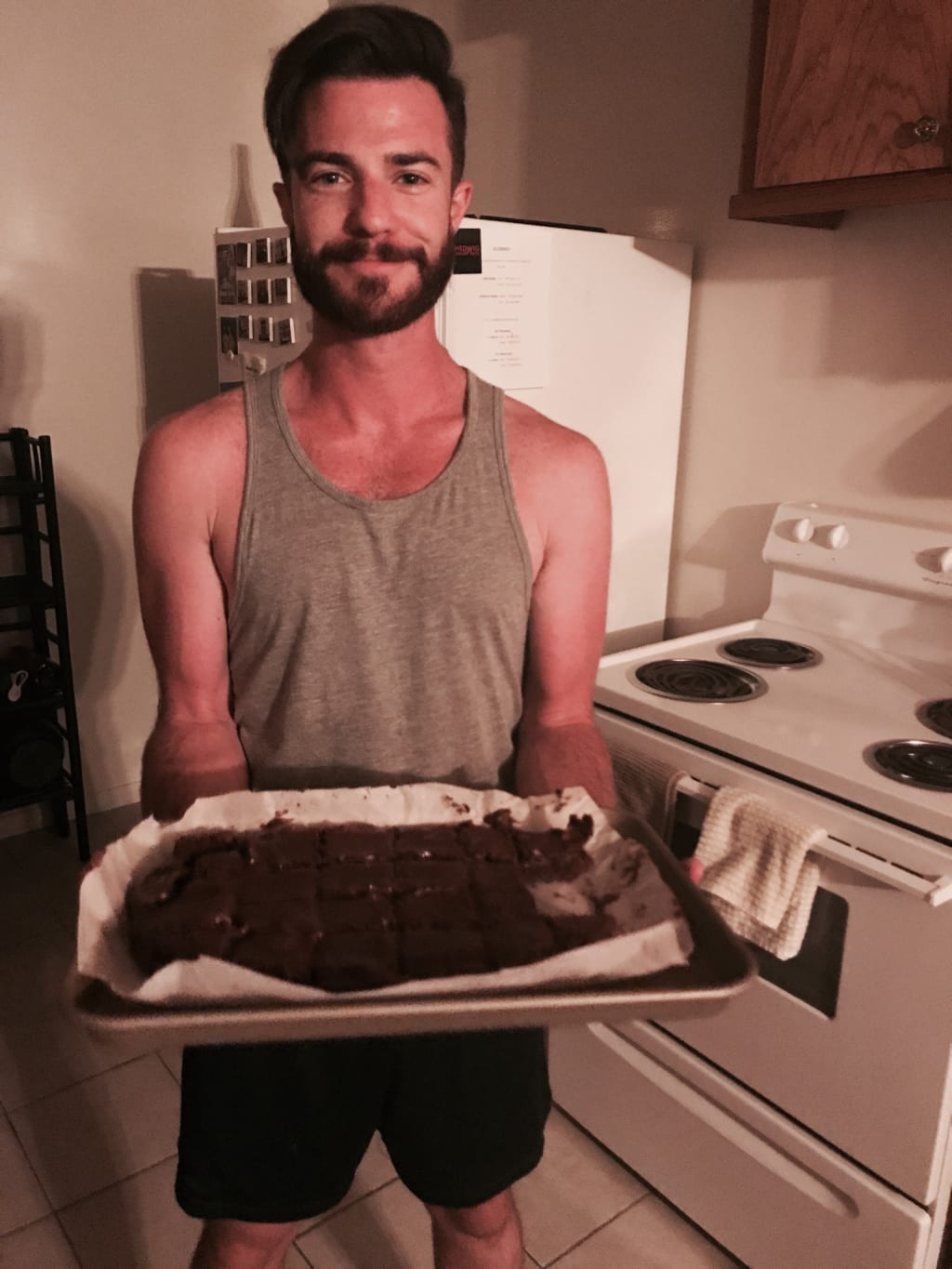Coming Out Twice: Being a Gay Diabetic
My Worlds Collide Daily

I remember the first time I stopped sex because of diabetes. I was 20 years old living on campus in Chicago for a summer job — a long-time friend we’ll call Nick decided to drop by, leading to a hook up. Things were moving along nicely until my pancreas slammed on the brakes. The room became a tunnel. My limbs were weak and began to shake. I felt cold sweat cover my palms. Nick looked confused and concerned, because of course he did. Not many know what a low blood sugar episode looks like, even when over 1.2 million people grapple with type 1 diabetes in the United States.
I don’t remember what I had on hand this time to correct my low level. My usual assortment of sugar boosters range from fast-acting glucose tablets to cereal to orange juice— anything to rapidly counter my body’s plunge and avoid a 911 call. I checked my blood sugar using my glucose monitor. Sure enough, my reading was in the low zone. Nick sat in the corner, both of us still naked, patiently waiting while things came back up. 20 minutes later, things were definitely back up, but back up as it were, we continued with uncertainty. Years later, Nick told me this was a memorable moment for him because of my vulnerability. His kindness diluted the embarrassment I felt, but I still cringe at the tainted intimacy.
For type 1 diabetics, blood sugar dropping during sex is an unavoidable reality. You’d be amazed at what triggers a hypoglycemic episode. Anxiety, heat, stress, sunburns, walking too fast after dinner are just some of the variables one has to consider. That’s all in addition to avoiding overdosing on the insulin you need to survive. As a type 1 diabetic since the age of 16, this encounter was the first time my chronic illness impacted my sex life. My body went from attacking itself from the inside, to sabotaging my relationships as I was coming out.
I realized that being diabetic, like being gay, forces me to come out on a daily basis.
Diabetes exists in our lives without a deeper understanding of what it is. We all know someone with it, or know we’re pre-determined to get it, or have made jokes about getting it after eating a plate of doughnuts. Basically, having diabetes means your pancreas is broken. The most important responsibilities a pancreas has in a healthy body are assisting with digestion and blood sugar regulation. Diabetes impacts the latter function. The pancreas consists of cells that produce insulin to break down food and turn it into energy, which regulates blood sugar levels.
Most have heard of diabetes without understanding the difference between type 1 and type 2. Type 2 diabetes, the more common of the two that mostly impacts older adults, is a metabolic disorder where the pancreas produces insulin, but not enough to properly turn food into energy. Type 1 diabetes is an autoimmune disease causing the pancreas to stop producing insulin altogether. Your immune system destroys the cells that produce insulin, leaving no way to break down the food you eat. Any sugar you intake remains trapped in your blood stream, causing excessive thirst, frequent urination, and exhaustion. There’s still no known cause, and no way to prevent it.
In past centuries, diabetes was a death sentence. Patients were forced on sugarless, low carbohydrate diets that bought them time, but couldn’t prevent the disease from further eroding their immune systems. In the 1920s, Dr. Frederick Banting of Canada researched and developed synthetic insulin safe for humans. Since then, developing type 1 diabetes has become a manageable condition, but still requires one’s full attention and consideration to avoid long term complications such as vision impairment and nerve damage. These physical effects exist alongside the mental toll the disease takes on affected individuals. Type 1 diabetics constantly think in numbers and questions: How many carbs does this meal have? How much insulin do I need to ensure it doesn’t spike my blood sugar? Do I need to take additional insulin to counter the big breakfast I had? Should I take less if I’m working out later?
Coming out as a diabetic elicits surprisingly similar responses to coming out as gay. Of course, nothing compares to the heartbreaking rejection many LGBT folks face from family and friends. But the experiences intersect when you consider the shame and fear of judgement. Acknowledging my status as a diabetic means acknowledging a disability. People with all types of disabilities struggle with acceptance, both inside and out. I’ve had people ask me, “Oh, you used to be really overweight?” and “Do you have an unhealthy lifestyle?” Eating carbs is already a sin in some minds, let alone as a gay diabetic. These questions echo LGBT-aimed ones such as “Who’s the man and who’s the woman in your relationship?” or “Why did you choose to be gay?” In both situations, there’s an assumption of fault based on the ignorance of the other party. Stereotypes plague both experiences. On multiple occasions, revealing I’m diabetic at a dinner table raises concerns from other diners, like, “Are you sure you should be eating that?” or, “Well, we definitely won’t be getting dessert! *laughter*” Don’t get me wrong, I’ve joked about my illness with plenty; it’s my go-to coping mechanism. I’ve also had to gently tell friends that joking about me dying after eating a piece of cake, even with our dark sense of humor, isn’t funny.
Pulling my insulin pen out of my pocket at a gay bar while Ariana Grande sings about walking side to side alarms even the most desensitized patrons. If I want to hang with the gaggles at the clubs, I have to closely watch my drink count, monitor my blood sugar, and listen carefully to my body. If you’ve been under the influence of alcohol or any drug, you know your mind and body aren’t exactly communicating effectively. I’ve received plenty of mixed signals during nights out where I’m convinced my blood sugar’s too low, or too high, and I have to excuse myself to check it. Irresponsibly, I’ll sometimes guess and hope I heard the right message. If it’s too low, I’ll pause the whiskey diets for a regular coke. Too high, the insulin pen is out and stealthily injecting my stomach or leg, depending on how short my shorts are for the evening.
At a 2011 Robyn concert in Detroit, literally right before she hit the stage, I collapsed. It was the first time I’ve passed out in my life, and my first time experiencing a major diabetic complication. I felt my blood sugar spiraling and ordered a Red Bull to shoot me upwards before Robyn sang her first notes, but I was too late. My body started jerking, like my muscles were spooked. I felt light-headed, then looked confusingly at my friends. “I feel really weird.” Slam. I hit the ground. When I came to, an emergency responder was helping me up the stairs of the venue as I bled from my mouth due to biting my tongue on the way down. When we got to the hospital, I kept apologizing to my friends, less mortified that I scared the shit out of them and more depressed they had to leave the Robyn show. Thankfully, I’ve always had supportive friends, but even my closest ones don’t understand the shame and embarrassment I experience when diabetes interrupts my life.
While going low at a bar isn’t an exclusively gay thing, I sometimes labor over the social drinking aspect of gay culture. Sunday Fundays? Sometimes I dread them. Already a jarring time of day to be drunk, bingeing after a late morning brunch can be a bumpy ride for diabetics, especially when your entire table wants to do bottomless mimosas. Sure, I love a properly portioned mimosa (read: champagne with a splash of orange juice), but too much orange juice will have me under the table faster than the bubbly. Each drink requires close calculations and repeated injections that aren’t worth the trouble. As the day progresses, I have to take breaks and find a place away from the chaos to check my levels. I get anxious wondering how my blood sugar is responding to the brunch I just ate, or the drinks I’ve consumed. Alcohol and diabetes aren’t exactly a perfect pairing. When you drink, your liver is working hard to remove the alcohol from your blood, distracting it from its other job of using insulin to break down carbs. It’s an extra, necessary level of caution preventing me from letting loose with the rest of my friends.
Thanks to technology from companies like Dexcom, diabetics can check their blood sugar by right-swiping the lock screen on their phone. Continuous glucose monitors (CGMs) use a tiny sensor inserted into the subcutaneous tissue in your stomach, arms, thighs, or upper buttcheek. They’re attached to a Bluetooth transmitter that sends a signal to a Bluetooth-enabled device every five minutes, providing instant blood glucose readings without having to prick a finger. It’s badass, but also adds a different type of anxiety to the mix. I’d have days where I was constantly wondering and swiping to see how I was doing. I was over-controlling and overcorrecting. For example, if I saw my levels were somewhat low but within range, I’d have a carb boost to make sure it didn’t go lower. This might cause a spike, or hyperglycemic episode, which is just as physically and mentally taxing as a hypoglycemic one.
As with being gay, nobody can tell you’re type 1 diabetic based on your looks. When your medical technology is visible, however, people naturally wonder what the hell you’re wearing. Take the beach. I enjoy wearing a cute swimsuit just like any gay. Depending on how scandalous my swimsuit is, the device is plainly visible, inviting stares, whispers, and questions. CGMs kind of look like space gear suctioned to your arm. I’m fine if people are curious and happy to answer any questions they ask; that’s crucial for educating the population about type 1 diabetes. Sometimes, though, I just want to relax, not talk, and not have a weird tan line caused by the patch the monitor uses to adhere to my body.
Additionally, I want to look good wearing this cute swim suit. My insecurities about my body often combine with my anxieties over being diabetic. I’m never going to be a ripped Instagram model, nor do I want to be, but I care about my body and my physical appearance. I’ve seen my friends and fellow community members accomplish physical fitness feats beyond my imagination: marathons, triathlons, 545 mile bike rides to benefit AIDS. It’s inspiring!...and it’s super intimidating. When I’ve amped myself up to go on a muscle-building diet, or push myself through a grueling group fitness class, diabetes taps me on the shoulder and says, “Ehh, I dunno about that.”
Recently, I stopped wearing my CGM and switched to the OneDrop manual glucose monitor. I’d be lying if I said a level of embarrassment didn’t impact my decision. Wearable diabetic technology is incredible, life saving, and a crucial part of many diabetics’ routines. However, it’s also a constant, physical reminder of a sometimes hourly struggle. There are days where I count carbs correctly, dose insulin accurately, and stay in my target blood sugar range. There are others where I curse my body for its inefficiencies, eye rolling at the awkward bruises on my stomach and thighs caused by insulin injections.
All of these components — drinking, going out, fashion, fitness — they’re social facets of LGBT culture. Gay bars are safe spaces where we engage with our chosen family free from judgement, essential to fighting the social stigmas still plaguing the LGBT community. I enjoy having a drink with friends at Flaming Saddles while toned cowboys and cowgirls swing from stage to stage, and I was pumped to debut the 80s inspired (read: low-cut) swim shorts I bought for the gay area of the beach this summer. I want to go on hikes in the Hollywood Hills with my boyfriend without my disease slowing us down. This fall, I’ll be participating in the Los Angeles AIDS Walk, but need to take extra precautions with my health. LGBT culture is important to me and worth the work to fit it alongside being diabetic. I’ve met a few gay diabetics and discussed these same scenarios, feeling so relieved to have someone who fully understands. “Is that an insulin pen in your pocket or are you just happy to see me?” joked one friend. It’s exactly like talking to someone from the LGBT community and bonding over shared experiences, existing in a society that doesn’t always understand you.
My fellow diabuddies of all orientations, I hear you. I see you. When I meet you randomly at a cupcake shop and joke about cranking up the insulin to enjoy some sweets, there’s a feeling of camaraderie that anybody without our condition can’t comprehend. Living with type 1 diabetes and managing it effectively is a 24-hours-a-day, 7-days-a-week, 365-days-a-year job with no benefits or pay. It’s like constantly being asked to guess a number, except getting it wrong makes your body revolt. Sometimes, I forget to acknowledge and embrace my situation. I have to remember that I’m allowed to be frustrated with my illness, while not letting it define me. Being a diabetic, much like being gay, is part of who I am but not all of me. Check your blood sugar, value your health, and love yourself.
About the Creator
Jake Giles
Brought up on dial-up. Queer and creative.






Comments
There are no comments for this story
Be the first to respond and start the conversation.